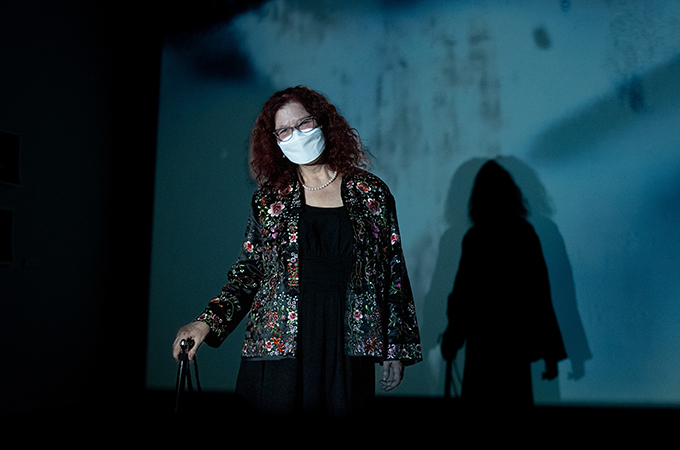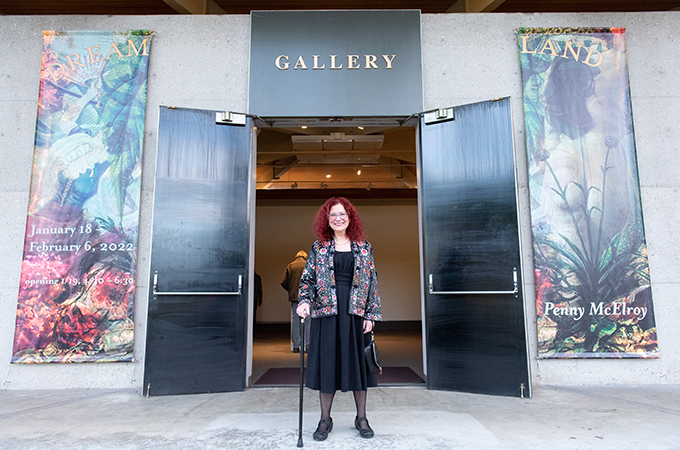Currently on display in the University Gallery on the main Redlands campus, Art Department Chair and Professor Penny McElroy’s Dreamland features multi-layered composite prints alongside video narratives and projections. Each image is a glimpse into the land of dreams, where minds move from the rationality and worries of waking life toward peace and nonsense. Katie Olson of the Bulldog Blog spoke with McElroy about her inspiration for the show and how her artistry influences her academic life.
Bulldog Blog: Where did the show’s title, Dreamland, come from?
Penny McElroy: I created much of this work on my sabbatical, way back in 2019. When I started working on it, I realized I had this title in my mind. It was based on the crazy logic of a dream, which exists in the work I like to do. I had this persistent feeling that the title of the show should be Dreamland. [The show also] relates to the kind of experiences you have when you're dreaming. I'm a lucid dreamer, and I tend to remember my dreams. Although I don't try to illustrate them, they're inspiring to me.
BB: Do the pieces in the show tell one cohesive story?
McElroy: There isn’t a cohesive story, but a couple of different threads that relate to each other. The way I look at it, there is a story embedded in each of the pieces. One big wall displays small prints I made on Risograph machine; I really have fallen in love with the Risograph. The two books I made are editioned books—meaning there are a number of copies that are all the same. Both include poetry I wrote. I love language and I like to write, so I wrote these poems and then created these books.
Another series of work is displayed on digital frames playing a video I made. Hanging in front of the frame is a layered image. These pieces have layers of thin, translucent paper, with images printed on top of them. That way, the video flickers through the paper. From making those pieces, I decided I wanted to try to experiment with telling stories with video. So, I created three video pieces displayed on digital frames, and then two big installation videos projected onto two walls of the Gallery.
The pieces all revolve around the idea of what is in the light and what is in the shadows. Video does that literally, and I'm excited about the projected pieces, because they redefine the space of the Gallery in a in a way that is mysterious and dreamlike. The projectors are set up across the room from the wall they're projecting on, so when people walk in and around the Gallery, they contribute to the image on the wall, and the video is projected onto their bodies as well as the wall. I was really intrigued with the idea of the projections being constantly altered by the viewers.
BB: When you were creating these pieces, did you have the University Gallery space in your mind?
McElroy: I did. When an art professor has a sabbatical, they create all this work and must have a way to report back. For an artist, “reporting” means —you put the work into a show and open it to the community. The show really should have been last year, but we weren’t able to do that [because of the COVID-19 pandemic]. This particular kind of work just doesn’t translate well online, especially the projections. So, I postponed the show, and I’m happy I did because it gave me some more time pull it together and make more new pieces.

BB: Can you tell me about the experience of creating the show? Is the creative process meditative for you or is it stressful?
McElroy: During my sabbatical, I had time to think and make mistakes. That's one of the biggest blessings of sabbatical. When the show got closer, then a second way of being with the work rose up: “Do I have enough? Am I showing everything I want to show? What should I edit out? How am I going to get this stuff up on the wall? How am I going to make this all work together?” The show is up now, but it took me three weeks. Part of that three weeks was devoted to rethinking a piece that I had not been able to really see until it was installed in the gallery. I had created these layers of silk that were about ten feet long by five feet wide. The idea was to hang those in the center of the Gallery, and then project these videos onto them –two separate videos projected onto the two sides of the hanging fabric. I spent weeks making them. Once I hung them up, I didn't like it. When I was fooling around with them, I projected one of the images on the back wall of the Gallery, and I really liked how it looked. So, I took down the fabric and began creating the projections. This is exactly what artists have to do all the time – working really hard on something and then sometimes having to abandon it. I kept the layers of fabric of course, and maybe I'll use them in something else, or maybe I won't. But to me, that was kind of an encapsulation of the art process.
BB: Have you always worked with video?
McElroy: No, my background is in old-fashioned hand-working methods—my MFA is in graphics. At the time, that meant printmaking and graphic design without computers. I still love that kind of work. In 2017, I had a pretty rough year, because I lost both my brother and my mother. But before that happened, I had been thinking about my brother and about living and dying, what that meant, and how that could be represented. I was thinking about how ephemeral life is and how light diffuses and focuses. I wanted to make things that were lit from within. In making these pieces, I taught myself how to use electronics and wire up LED lights, I made the frames, and created these layered paper pieces that had fragments of images that would be seen with light behind it. I really wanted what I got, which was difficult-to-discern images that go in and out of focus, depending on the climate and the air in the room. That’s where my interest in this kind of thing started—it was thinking about how light works.
BB: You created this show right before the COVID-19 pandemic. Do the past two years give you a new perspective? Did the pandemic change your approach to making art?
McElroy: Yes and no. I don't think the pandemic is responsible for the shift in my interests. But I can see how the necessity to isolate has made my thoughts turn inward. The pandemic also requires and continues to require a lot of courage and resilience; that, too, has changed the way we think about everything in some way. The pandemic has made me think a lot about how we fill ourselves up with energy, and how we recognize when we’re depleted, and then we refill ourselves and establish our own sense of kindness and empathy towards ourselves and other people. I don't think that's literally in my work, but it's in my practice.
BB: How does your work as an artist influence your role as a professor?
McElroy: It's vital. I think any professor would say that if they're not engaged in their field, they can't be a good teacher. I talk pretty directly to students about how we maintain the things we love under these circumstances. I have to assume that the students love making art as much as I do. How do we sustain that? So, I developed some ways of keeping on that worked for me, and I talk to the students about it. Right now, I'm teaching the senior project class, which is the capstone for all our majors. We're having a lot of one-on-one conversations, and with many of them I reference to my own experiences as an artist. With art, you impart your thinking – you communicate a feeling, an idea, a question. But to do that, the artist has to assume that there will be someone looking at this one day and speak to that person. For me, the process of communication through visual means involves a combination of intellect and instinct.
BB: What do you hope people glean from the show?
McElroy: I hope they are intrigued by the stories being told. I hope there will be something they take away and think about again. I hope they feel like they entered a moment in the dream world.
Learn more about the College of Arts and Sciences or studying art at the University of Redlands.






